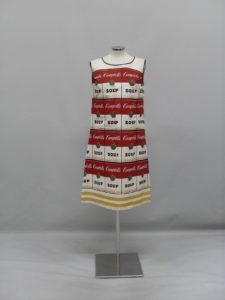The Ready to Tear Trend of Paper Dresses
Originally published in 2012 on vintagefashionlondon.co.uk (owned by Visibility IQ and now defunct)
When we think of paper clothing, images of hospital gowns and disposable coveralls first come to mind, but in the early 1960s paper dresses were all the rage. At the time, there was even speculation that the fad might lead to a shift in disposable cellulose-based fashions for the whole family.
While the notion of disposable clothing seems unlikely to take hold today, the period from the 1940s to the 1960s was a brave new world for advances in convenience and disposable consumer goods. Disposal nylons, pens, cigarette lighters, razors, diapers, paper plates and plastic-ware were still a novelty and not considered a wasteful challenge to overcome. Convenience was king in the marketplace and consumers didn’t worry about dwindling resources and overflowing landfills.
Enter the paper dress—the ultimate in convenience. No need to wash, dry, iron or even hang it up. Open the package, pop it over your head, wear it out on the town, and at the end of the night toss it in the bin.
The first paper dress was created by the Scott Paper Company in 1966 as a marketing gimmick. Customers could send in $1 and receive the Paper Caper dress plus 52 cents worth of coupons for Scott Paper products. The campaign was wildly successful and over 500,000 dresses were mailed out. This marketing strategy sparked a craze during which millions of paper dresses were produced for the consumer market over the period of about two years.
What could have possibly made these dresses so popular? The 1960s was the decade of the Space Race, The Jetsons, and 2001: A Space Odyssey and Americans were obsessed with space, technology and all things futuristic. Paper dresses must have seemed the ultimate in modern and out-of-this-world fashion.
Additionally, the dresses were considered fashion forward and many featured Pop Art designs or other eye-catching and novel designs, like Andy Warhol’s Campbell Soup paper dress or designs featuring political candidates. The shift dress was the most common silhouette, but the fad even spawned the creation of paper wedding dresses.
Paper dresses were so popular they were even featured in Mademoiselle magazine in 1967, which said, “The paper dress is the ultimate in smart money fashion.”
Even though Mademoiselle might have disagreed, the dresses were not necessarily inexpensive. The average cost was around $8, which was the same as a conventional shift dress from Sears Roebuck & Co in 1966, and by their very nature they were completely impermanent.
Ephemeral by their design, the trend fell out of fashion and the mass-manufacturing of paper dresses ceased by 1968.
